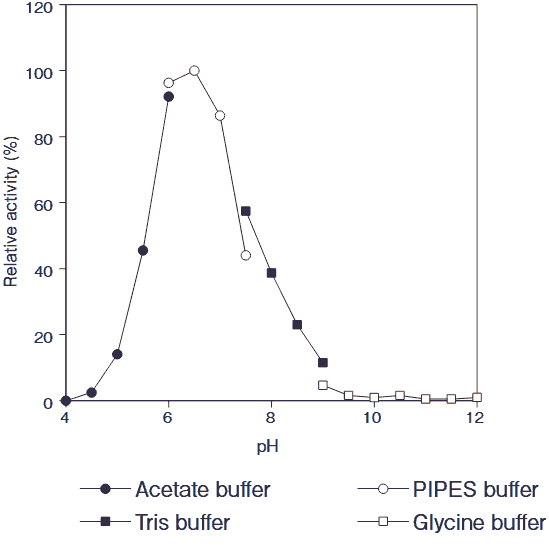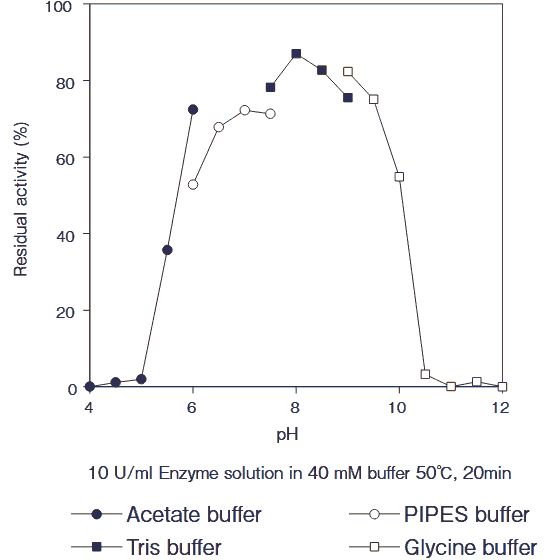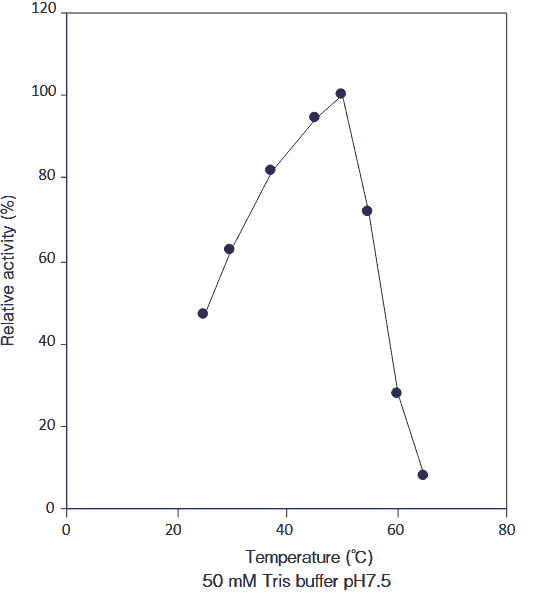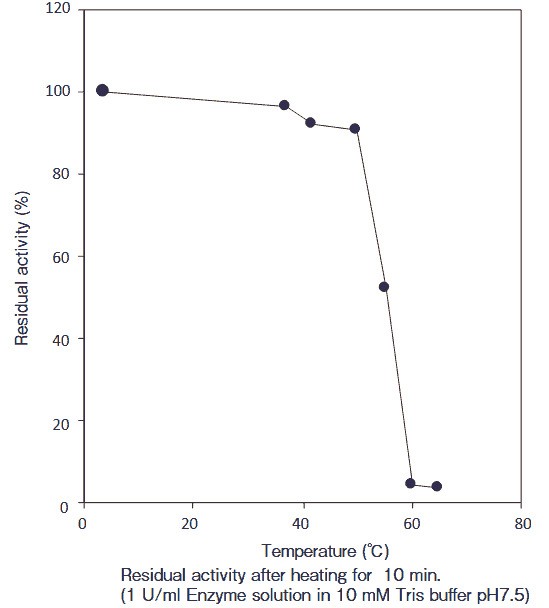FRUCTOSYLAMINE OXIDASE[FOD III]
from Microorganism
(Ketoamine oxidase, EC 1.5.3)
D‒Glucose + acceptor → D‒glucono‒1,5-lactone + reduced acceptor
Preparation and Specification
- Appearance
- : Yellowish lyophilized powder
- Specific activity
- : More than 10 U/mg solid
Properties
- Molecular weight
- : 49 kDa (SDS-PAGE)
- Michaelis constant
- : 1.61 × 10-3M (Fructosyl valylhistidine)
- Optimum pH
- : See Figure 1
- pH stability
- : See Figure 2
- See Figure 2
- : See Figure 3
- Thermal stability
- : See Figure 4
- Substrate specificity
- : See Table 1
- Effect of various chemicals on FOD Ⅲ activity
- : See Table 2 and Table 3
Applications for Diagnostic Test
This enzyme is useful for the measurement of the glycated hemoglobin (HbA1c) in human whole blood.
Table 1. Substrate specificity
| Substrate | Relative activity (%) |
|---|---|
| Fructosyl Valine | 436.0 |
| Fructosyl Valine-Histidine | 100.0 |
| Fructosyl Valine-Leucine | 0.9 |
| Fructosyl Valine-Histidine-Leucine | 0.0 |
| Fructosyl Valine-Histidine-Leucine-Threonine | 0.0 |
| Fructosyl Valine-Histidine-Leucine-Threonine-Proline | 0.0 |
| Fructosyl Valine-Leucine-Threonine-Proline-Leucine | 0.0 |
Table 2. Effect of various chemicals on FODIII activity
| Additives | Concentration | Relative activity (%) |
|---|---|---|
| None | - | 100 |
| MgCl2 | 0.5mM | 101 |
| MnCl2 | 0.5mM | 103 |
| CaCl2 | 0.5mM | 103 |
| LiCl | 0.5mM | 103 |
| NaCl | 0.5mM | 110 |
| CoCl2 | 0.5mM | 12 |
| CoCl2 | 0.5mM | 44 |
| KCl | 0.5mM | 107 |
| EDTA | 1mM | 109 |
| TritonX-100 | 0.1% | 100 |
| Sodium cholate | 0.1% | 98 |
| Tween 80 | 0.1% | 103 |
| Tween 60 | 0.1% | 103 |
| Briji 35 | 0.1% | 105 |
Table 3. Effect of various chemicals on FODIII activity
| Additives | Concentration | Relative activity (%) |
|---|---|---|
| None | - | 100 |
| KCl | 1mM | 101 |
| 20mM | 95 | |
| 100mM | 84 | |
| NaCl | 1mM | 97 |
| 20mM | 93 | |
| 100mM | 86 | |
| 250mM | 68 | |
| Sodium lauryl sulfate4 | 0.01% | 94 |
| 0.03% | 77 | |
| 0.05% | 3 | |
| 0.10% | 0 | |
| Ethylene glycol | 1% | 89 |
| 2% | 76 | |
| 5% | 57 | |
| 10% | 39 | |
| 20% | 17 | |
| Dimethyl Sulfoxide | 1% | 87 |
| 2% | 77 | |
| 5% | 61 | |
| 10% | 42 | |
| 20% | 22 | |
| 2-Hydroxypropyl-β-cyclodextrin | 1% | 97 |
| 3% | 92 | |
| 5% | 111 |
Table 4. Effect of various chemicals on FODIII stability
| Additive | Residual activity (%) |
|---|---|
| None (40mM Tris-HCl pH7.5) | 71 |
| + 5mM EDTA | 85 |
| + 250mM KCl | 85 |
| + 250mM NaCl | 89 |
| + 20mM Sodium glutamate | 85 |
| + 20% Sucrose | 94 |
| + 20% Ethylene glycol | 86 |
| + 20% Glycerol | 91 |
| + 0.1% Triton X-100 | 64 |
| + 4% Sorbitol | 99 |
| + 0.1% Briji 35 | 65 |
| + 0.1% Tween 60 | 74 |
| + 0.002mM Flavin adenine dinucleotide | 76 |
| + 0.02mM Flavin adenine dinucleotide | 76 |
| + 0.002mM Flavin mononucleotide | 75 |
| + 0.02mM Flavin mononucleotide | 74 |
| + 10mM NH4Cl | 77 |
(3U/ml Enzyme solution)
Assay
Principle
-
The assay is based on the increase in absorbance at 555 nm as the formation of quinoneimine dye proceeds in the following reactions:
| FOD Ⅲ | ||
| 1-deoxyfructosyl-valinyl- |
→ | Glucosone+Valinyl-histidine+H2O |
| POD | ||
| 2H2O2+4–AA+TOOS | → | quinoneimine dye+4H2O |
Unit definition
-
One unit is defined as the amount of enzyme which converts 1 μ mole of deoxyfructosyl-valinyl-histidine to H2O2 per minute at 37 ℃ under the conditions specified in the assay procedure.
Reagents
- Reaction mixture
50mM Tris-HCl buffer pH 7.5 containing 1.0mM 1-deoxyfructosyl-valinyl-histidine and 0.03% 4-AA and 0.02% TOOS and 5.0U/mL POD - Reaction stopper
0.5% SDS solution - Enzyme dilution buffer
10mM Tris-HCl buffer pH7.5 - Reagents
Tris (hydroxymethyl) aminomethane: Sigma #T-1503
1-deoxyfructosyl-valinyl-histidine:Peptide Institute. Inc.
4-AA (4-Aminoantipyrine) : nacalai tesque #01907-52
TOOS (N-Ethyl-N-(2-hydroxy-3-sulfopropyl)-3-methylaniline, sodium salt, dihydrate) : DOJINDO LABORATORIES #OC13
SDS (Sodium lauryl sulfate) : nacalai tesque #31606
POD (Peroxidase) : Sigma Type Ⅱ #P-8250
Enzyme solution
-
Accurately weigh about 20 mg of the sample and add enzyme dilution buffer to make a total of 20 ml. Dilute it with enzyme dilution buffer to adjust the concentration as required.
Procedure
- Pipette accurately 0.5 ml of reaction mixture into a small test tube and preincubate at 37 ℃.
- After 5 min, add 10 μl of enzyme solution and mix to start the reaction at 37 ℃.
- At 5min after starting the reaction, add 1.0 ml of reaction stopper and mix to stop the reaction.
※ IIn the case of a test blank, add 10 μl of enzyme dilution buffer in place of enzyme solution after stopping the reaction. - Measure the absorbance at 555 nm.
Absorbance sample : As
blank : Ab
△ A = (As−Ab) ≦ 0.050 ~ 0.800 Abs
Calculation
-
Activity (U/mg of powder) = {(△A/5min)/(39.2×1/2)} × 1.51/0.01 × 1/X
= (△A/min×1.541)/X -
39.2 : millimolar extinction coefficient of quinoneimine dye at 555 nm (cm2/ μmole) 1/2 : a multiplier derived from the fact that 2 mole of H2O2 produces 1 mole of quinoneimine dye 1.51 : final volume (ml) 0.01 : volume of enzyme solution (ml) X : concentration of the sample in enzyme solution(mg/ml)
Storage
-
Storage at -20 ℃ in the presence of a desiccant is recommended.
FOD Ⅲ活性測定法(Japanese)
試薬液
- 反応試薬混合液
1.0mM 1-deoxyfructosyl-valinyl-histidine、0.03% 4-AA、0.02% TOOS、5.0U/ml POD を含む50mM トリス-HCl 緩衝液 pH7.5 - 反応停止液
0.5% SDS 溶液 - 酵素溶解希釈溶液
10mM トリス-HCl 緩衝液 pH7.5 - 試薬
トリス (ヒドロキシメチル) アミノメタン:シグマ製 #T-1503
- 1-deoxyfructosyl-valinyl-histidine:ペプチド研究所製
4-AA (4- アミノアンチピリン) :ナカライテスク製 特級 #01907-52
TOOS:同仁化学製 #OC13
SDS (ドデシル硫酸ナトリウム) :ナカライテスク製 #31606
POD (パーオキシダーゼ) :シグマ製 Type Ⅱ #P-8250
酵素試料液
- 検品約20mg を精密に量り、酵素溶解希釈用液に溶解して全容20ml とする。その液を酵素溶解希釈用液で適宜希釈する。
測定操作法
- 小試験管に反応試薬混合液0.5ml ずつを正確に分注し、37℃で予備加温する。
- 5 分経過後、酵素試料液10 μl を正確に加えて混和し、37℃で反応を開始する。
- 5 分経過後、反応停止液1.0ml を加えて混和し、反応を停止する。
※ 盲検は反応停止後に酵素試料液10 μl を加える。 - 555nm における吸光度を測定する。
求められた吸光度を試料液についてはAs、盲検液についてはAb とする。※ 吸光度範囲 ΔA = ( As - Ab ) = 0.050 ~ 0.800Abs
計算
活性 (U/mg) = {(△A/5min)/(39.2×1/2)} × 1.51/0.01 × 1/X={(△A/min)×1.541}/X
| 39.2 : | キノンイミン色素の555nm におけるミリモル分子吸光係数 (cm2/μmol) |
| 1/2 : | H2O2 2 モルからキノンイミン色素1 モルが生成することによる係数 |
| 1.51 : | 反応総液量 (ml) |
| 1.51 : | 反応に供した酵素試料液量 (ml) |
| X : | 酵素試料液中の検品濃度 (mg/ml) |







